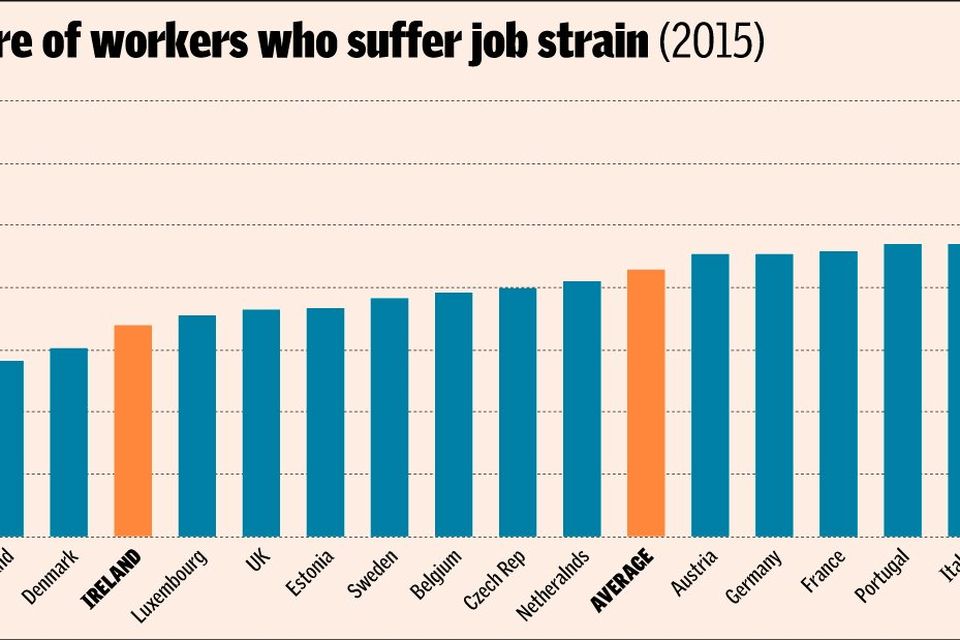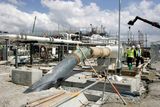Relax: Irish workplaces are relatively stress-free
Click to enlarge
With the summer in full swing, many of us are spending some time away from the strains of the workplace or planning on doing so. It is timely then, that a recent OECD blog post*, accompanied by a trove of bang-up-to-date data, looked at the issue of workplace strain across Europe.
It has some interesting findings. Among the most interesting (from an Irish perspective) is that workers here, on average, feel less job strain than most of their counterparts elsewhere in Europe.
This measure adds to other important gauges of the workplace and the quality of jobs in developed countries compiled by the Paris-based think tank.
All this is important because having a job and the quality of one's job strongly correlates with better health, self-esteem and general well-being. In contrast, being jobless tends to be harmful, for financial and non-financial reasons. Further, as an economy is the sum of all parts, one's contribution at work makes up a small part of what keeps society ticking along.
The importance of employment for economies and for people makes it a top priority for all governments. But quality matters as well as quantity. A job's remuneration and career prospects are important. A good working environment is crucial too. These things can make waking up in the morning more bearable.
Before coming to the job strain issue, the OECD has developed two other important indicators. One is "labour market security", which looks at the risk of job loss and the level of unemployment assistance, particularly important issues at a time when much of the darkening political mood across the rich world is being attributed - rightly or wrongly - to rising insecurity and people being "left behind" by technology and globalisation.
Another measure is "earnings quality" which looks at average earnings adjusted for cost of living and inequality within each member country.
By both of these measures Ireland was ranked in the middle among OECD countries. This column will return to these measures at a future date. But today, lets look at the third measure - "job strain".
The boffins at the OECD have done this work in an attempt to measure the quality of workplace environments for those who toil in them. There is plenty of good news.
Companies, particularly larger ones, have been trying to make workplaces better for workers to improve collaboration and productivity. In a world where competition for talent is intense, the need to develop a reputation as a place people want to work is important too.
Following the lead of Silicon Valley, many firms have improved the various amenities available in the workplace. For instance, Ryanair's new HQ in Swords boasts arcade games, pool tables and even - wait for it - a slide. A growing number of employers are offering more work flexibility, with working from a home a particularly popular example.
There are good, self-interested reasons for employers to pay attention to the well-being of employees. There is a wealth of research in occupational health, epidemiology, management and sociology showing that the quality of workplace environment has a profound impact on people's mental and physical health. If both can be sustained and/or improved by a good workplace environment, higher productivity, in terms of output and creativity, will follow.
"Strained" jobs are defined by the OECD as those in which workers face a higher number of job demands than the number of resources they have at their disposal. Job demands include time pressure (long, inflexible and intensive working hours are the proxy) and physical health risks (occurrence of workplace accidents is the measure used in this case).
Factors that reduce strain include workplace autonomy and learning opportunities (good management and training), and social support at work (the availability of help and being able to keep up good relationships with co-workers). Of course, some jobs, by necessity, come with stress. Construction and assembly line work is inherently more dangerous than desk-bound employment. Those who are self-employed or run their own business may need to work longer hours to keep the show on the road, or stay in control (there is no shortage of evidence that entrepreneurs are more motivated by control than cash).
Attempting to measure all of this so that comparisons can be made across similar countries is not only useful, but fascinating too.
The good news is that Ireland performs well, having one of the lowest rates of job strain among European OECD countries, as the chart shows. Although a third of Irish workers - a sizeable minority - reported strain, this is well below the average of 43pc across the countries surveyed. Only Denmark and Finland had a lower percentage in 2015.
Conversely, Greece and Spain have a majority of workers experiencing strain and are ranked at the other end of the league table.
The recession - unsurprisingly - appears to have damaged the quality of work environments in Ireland. Incidence of job strain was only 27pc in 2005, but rose to 36pc in 2010. That it has fallen back a bit since probably reflects the much improved and tighter labour market in recent years.
There is variation within the components of job strain. One variable where Ireland's performance is not particularly good is job pressure - just over half of Irish workers say their job contains long working hours and high intensity.
But on most other measures, Ireland ranks well, including comparatively low physical health risk and high levels of work autonomy and learning opportunities.
Ireland performs the best in terms of job resources, offsetting high demands, and is also first in the "social support at work" category - 43pc of Irish workers say they have good relationships at work that allow them to get assistance and discuss work-related problems with co-workers or supervisors.
This, of course, means that a majority claim not to have supportive colleagues they get along with at work - though looking abroad provides some reassurance. The rate is alarmingly low in other countries, such as Germany (13pc) and Italy (8pc). It appears we get along with each other at work better than most, a finding that this columnist is not surprised by - having lived and worked in six other countries I've always been struck by the just-get-on-with-the-job attitude of the Irish.
Education is usually a good indicator for levels of job strain. As would be expected, rates are much lower among the highly skilled compared with low skilled. Jobs that require lower levels of education come with less autonomy. Risks to physical health tend to be greater too.
On average in Europe, differences are less marked across the age groups than across skills levels. Interestingly, though, this is not the case in Ireland: strain is highest among younger workers (aged 15-29) and declines considerably as the age groups get older.
There are also gender differences. In a majority of countries job strain is higher for men than for women. The three exceptions are Austria, Finland and Ireland, where incidence is higher for women than men.
That women and the young stand out from their European peers is a subject this column will return to in the autumn when its author is a little less strained. If you are taking a break, enjoy.
*http://oecdinsights.org/2016/06/21/job-strain-affects-four-out-of-ten-european-workers/
Join the Irish Independent WhatsApp channel
Stay up to date with all the latest news















